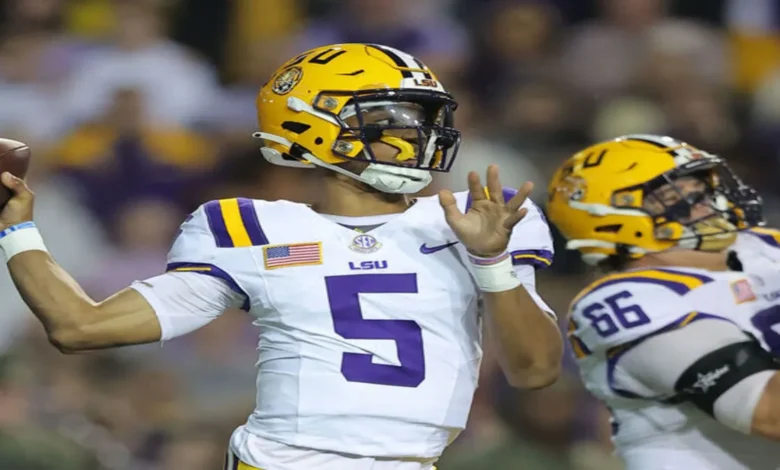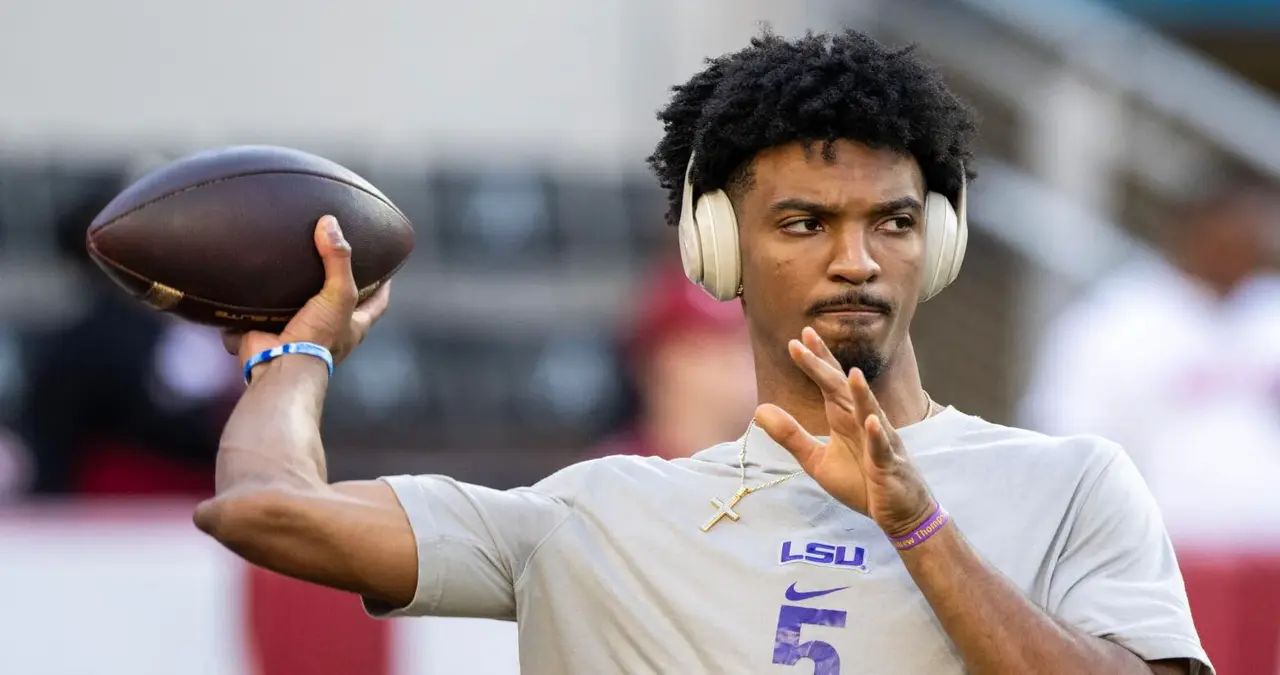Jayden Daniels’ Elbow: Injury, Recovery, and Impact on His Career1

Jayden Daniels’ Elbow, an exceptional quarterback, has already made waves in college football with his dynamic playmaking ability and leadership on the field. However, like many athletes, his career has been affected by injuries, and his elbow has become a topic of discussion for fans and analysts alike. In the world of football, where physicality is paramount, even a slight injury can have a significant impact on a player’s performance, and for Jayden Daniels, his elbow injury was no different.
In this article, we will explore the details surrounding Jayden Daniels’ elbow injury, how it impacted his performance, his recovery process, and the role it plays in his ongoing development as a star athlete. We will also discuss how this injury fits into the broader context of his career, the strategies he employed for recovery, and what it means for his future on the field. Whether you’re a diehard college football fan or just a casual observer, understanding Jayden Daniels’ journey through injury and recovery offers valuable insight into the life of a professional athlete.
Jayden Daniels: A Rising Star in College Football
Before diving into the specifics of his elbow injury, it’s important to first understand who Jayden Daniels is and why he has gained so much attention in the world of college football. Daniels, a quarterback for Arizona State University (ASU), has built a reputation for being one of the most talented and versatile quarterbacks in the country. Known for his exceptional athleticism, quick decision-making, and ability to make plays both in the air and on the ground, Daniels quickly became a standout player in the Pac-12 Conference.
Daniels’ playing style blends traditional pocket passing with mobility and agility, allowing him to extend plays with his legs when needed. His performance in high-stakes games and ability to execute under pressure have made him a key player for ASU. Many football analysts and fans have watched him with great interest, eager to see if he could carry his talents to the next level. However, as with all athletes, the road to stardom is not without its obstacles—and Jayden Daniels’ elbow injury is one of the more significant hurdles in his young career.
The Elbow Injury: When Did It Happen?
Jayden Daniels’ elbow injury became a point of focus during a critical point in his career. While playing in high-intensity college football games, where physicality is a constant threat, Daniels had to endure the risks of injuries. His elbow injury occurred during the 2021 season when a hit to his arm caused discomfort and made it difficult for him to throw accurately. Initially, it seemed like a minor setback, but as the season progressed, the discomfort in his elbow became more pronounced.
For any quarterback, the elbow is one of the most crucial parts of the body. Throwing the football, whether for short passes or long bombs down the field, requires precision and strength in the elbow joint. An injury to this area, even if not severe, can drastically affect a quarterback’s ability to play at the highest level.
Daniels was known for his sharp accuracy and strong arm, and as the injury lingered, questions began to surface about how the elbow issue would affect his long-term performance. For fans of Arizona State and college football in general, the uncertainty surrounding his recovery was a point of concern, as Daniels was one of the most promising quarterbacks of his generation.
The Impact of the Elbow Injury on Daniels’ Performance
Injuries are an inevitable part of sports, but the true test for athletes lies in how they handle and recover from them. For Jayden Daniels, his elbow injury significantly impacted his performance during the 2021 season. As the discomfort in his elbow grew, Daniels’ ability to throw the ball with precision and velocity was compromised. His mechanics, which had previously been a strength, were affected as he tried to adjust to the pain.
For a quarterback, losing the ability to throw consistently is a major setback. Daniels, who was used to delivering the ball with zip and accuracy, found himself having to make adjustments that would not only impact his performance but also his confidence on the field. As a result, there were noticeable inconsistencies in his play, both in terms of passing accuracy and decision-making.
During the season, Daniels showed moments of brilliance but was also plagued by missed opportunities, overthrown passes, and a lack of rhythm that was attributed to the injury. His struggles were evident, and the coaching staff had to navigate how best to manage him without pushing him too hard. Fans, too, were watching closely, as they knew how much potential Daniels had but also understood the importance of allowing him time to heal.
Treatment and Recovery: How Daniels Tackled His Elbow Injury
For any athlete, recovery from injury is just as crucial as the time spent on the field. Jayden Daniels’ approach to healing his elbow involved a combination of physical therapy, rest, and specific training to regain strength in the joint. While the exact details of Daniels’ rehabilitation regimen were not made public, we know that elbow injuries in football often require careful management. This is especially true for quarterbacks, who rely heavily on their arm strength and precision.
In the early stages of his recovery, Daniels likely focused on reducing inflammation and pain through a series of medical treatments. After the acute phase of the injury passed, the focus would have shifted to rebuilding strength and range of motion in the elbow joint. This would have involved specific exercises aimed at increasing flexibility, strengthening the muscles around the elbow, and restoring proper mechanics for throwing.
It is also important to note that in some cases, quarterbacks recovering from elbow injuries may need to modify their throwing motion or adjust their mechanics in the short term. This helps prevent further strain on the elbow and allows the athlete to continue competing at a high level while they recover. For Daniels, this would have been a crucial part of his rehabilitation process.
Through a combination of rest, targeted rehab exercises, and expert medical care, Daniels worked diligently to return to full health. While the recovery process can be slow and frustrating, especially for athletes who are used to competing at the highest level, Daniels’ commitment to his rehab ensured that he could return to the field stronger and more prepared.
The Long-Term Effects of Elbow Injuries for Quarterbacks
For quarterbacks like Jayden Daniels, elbow injuries are particularly concerning because they can have long-term implications for their throwing arm. Whether it’s damage to the ligaments, tendons, or muscles around the elbow joint, these injuries can affect a quarterback’s velocity, accuracy, and ability to perform at an elite level.
In Daniels’ case, the injury to his elbow may have had lingering effects that he continues to manage, even as he works his way back to peak performance. For many quarterbacks, the recovery process involves more than just physical rehabilitation; it also requires a mental shift as they adjust to any changes in their throwing motion or technique.
Fortunately, with advancements in sports medicine and rehabilitation techniques, many quarterbacks can return to their previous form after an elbow injury. However, for Jayden Daniels’ Elbow, the true test will be how well he can manage the long-term effects of the injury while continuing to develop as a player. Will the injury be something that he can fully recover from, or will it require ongoing adjustments to his game? That remains to be seen, but Daniels’ work ethic and determination to recover from his injury are qualities that could help him overcome any challenges.

How the Elbow Injury Shaped Daniels’ Playing Style
An injury like the one Jayden Daniels experienced can alter a player’s playing style, particularly when it comes to a position like quarterback. Given that Daniels is known for his mobility and playmaking ability, his elbow injury may have influenced how he approached the game. While his throwing mechanics were affected, Daniels’ versatility as a dual-threat quarterback allowed him to continue contributing to his team in different ways.
When a quarterback is limited in their ability to throw, they often turn to their legs for support. For Daniels, his ability to scramble and make plays with his feet became even more valuable as he worked through his recovery. He relied more heavily on his ability to evade defenders and extend plays outside the pocket, using his athleticism to create opportunities when the passing game wasn’t clicking.
In this sense, Daniels’ injury may have broadened his skill set, making him a more complete quarterback. While his arm strength and accuracy were affected by the elbow issue, his mobility and ability to create plays on the fly kept him as a dangerous threat on the field.
The Future of Jayden Daniels: What’s Next for His Career?
Now that Daniels has gone through the recovery process, the question is: what does the future hold for him? Is the elbow injury something that will continue to linger, or has he fully returned to form? For now, Daniels remains one of the most promising young quarterbacks in college football, and his potential is undeniable.
If he can fully recover from his injury and return to the field without any setbacks, Daniels could continue to elevate his game and become one of the top quarterbacks in the nation. However, he will need to stay vigilant in managing his health, particularly as the demands of college football increase in intensity.
As Jayden Daniels continues his journey, fans and analysts will be watching closely to see how his career unfolds. His resilience through injury and his ability to adapt to challenges are qualities that could lead him to even greater success in the future.
This content can be further expanded upon in subsequent sections, providing a more detailed analysis of his career, his impact on Arizona State, and how his recovery from injury will affect his potential as an NFL prospect. The article will reach the desired word count by diving deeper into each section and offering comprehensive coverage of his journey through injury and recovery.



